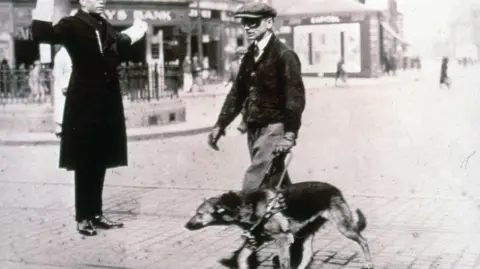The town where guide dog puppies learn their job
 Guide Dogs
Guide DogsGuide dogs-in-training have become a daily sight in one Midlands town.
But when the national Guide Dogs charity moved in to Leamington Spa in the 1940s, residents were bemused by the spectacle of pups being taught to stop at kerbs and steer round obstacles.
Owners and trainers share their memories of the charity's early years in the town, including Blue Peter parties and sneaking into kennels to play with the puppies.
In 1940, Edmonscote Manor in Leamington Spa became Guide Dogs' first permanent base.
Although it had been founded a decade earlier in Wallesey, Merseyside, as it grew the organisation needed a more central site, with access to training areas and kennels.
After a UK-wide search, Edmonscote Manor came out on top and remains the charity's regional headquarters; the area its unofficial home.
"It just feels like we've been part of that local culture from those very early days," says Graham Kensett, the current head of Canine Assisted Services.
"Guide dogs is just seen as part of Leamington."
 Guide Dogs tbc
Guide Dogs tbcThe organisation's first permanent trainer was Captain Nicholai Liakhoff, a former Russian Imperial Guard who moved to Leamington to serve Guide Dogs until his death in 1962.
In the early years, a variety of breeds, including Boxers, Poodles and Dalmatians, were tried in training, the animals often donated or from shelters.
But by the 1960s, the proportion going on to work as guide dogs was still too low.
So a breeding programme began, masterminded by a Leamington kennel manager who would soon become familiar to generations of Blue Peter viewers.
 Guide Dogs
Guide DogsDerek Freeman's daughter Helen was born in 1970, the same year the breeding programme moved to a second site three miles away, in Bishops Tachbrook.
Growing up in a bungalow in the grounds of Tollgate House, she would sneak out to visit the dogs with her twin Sarah and older sister Judith.
"Mum would think we'd gone to bed and she'd go and check the room and we'd be in the kennels sitting and playing with puppies," she says.
Her father's association with Blue Peter began in 1964, when an appeal led to the sponsoring of trainee guide dog Honey.
Over a period of 20 years, he trained the programme's string of guide dogs, often appearing on TV surrounded by wriggling puppies.

Helen remembers visiting the BBC studios and going to the programme's summer party.
"It was always quite entertaining and novel when we were growing up," she says.
In those days it was common for the dogs to be fed sheep heads and even rice pudding, and she recalls on one occasion a delivery lorry got stuck.
The family had to help unload hundreds of tins of rice pudding in a layby.
"Somebody reported us to police, thinking we were nicking stuff off the lorry," Helen laughs.
She has worked at the charity for years, and currently looks after mums and puppies yards from her old house at the National Centre, built in 2011.
"It's in my genes," she says. "It's a wonderful job to have."
 Helen Freeman
Helen FreemanDuring his own working life, Freeman oversaw the rearing of 20,000 pups and helped found and develop a puppy walking programme, which continues today.
In 2024, more than 1,000 puppies were born at the Tollgate site, where a new building adjacent to the original opened in 2011.
The National Centre is now the largest breeder of assistance dogs in the world, with guide dog mums-to-be are homed by volunteers within an hour's drive away.
 Guide Dogs
Guide DogsUntil the early 1990s, guide dog owners would stay on-site at Edmonscote as they partnered with their new pups.
"People could come away and put all their troubles behind them, focus on the dog training and go away three weeks later with a four-legged friend almost ready to have the L-plates removed," says Graham.
In 1973, Maggie Bowes was just 22 and petrified as she arrived from Essex.
"I didn't even know how to put a dog lead on," she says.
When she met her Golden Retriever Hoboe, the dog cried at the door for its trainer.
But, over a regimented four weeks, Maggie learned voice commands, foot positions and how to walk Hoboe around town.
Days after they left, the pair successfully navigated several trains and tubes to reach her office in central London.
 Provided
Provided"You kind of think, can she really do it, can I do it? Like driving a car for the first time," she says.
Now living in Warwick, Maggie is partnered with her seventh Leamington-trained dog.
"It was the best thing I ever did," she says. "I hated and still hate using a white cane.
"People talk to you when you go out with your dog. Friendships happen."
 Guide Dogs
Guide DogsWhereas years ago, partnerships might be switched at the eleventh hour, there is now an emphasis on matching dogs and owners early on.
Dog mobility specialists also focus more now on positive reinforcement than correction.
"We need to capture the differences in society really and they reflect the training approaches that we take now," Graham adds.
 Guide Dogs
Guide DogsLooking to the future, the organisation is exploring how new technology will integrate with the "friend at the end of the lead".
The guide dog itself is not only a mobility aid but is combatting loneliness and isolation as well, says Graham.
"I don't see that we get to an android dog, not in the near future. I think guide dogs have still got good longevity," he said.
 Guide Dogs
Guide DogsFollow BBC Coventry & Warwickshire on BBC Sounds, Facebook, X and Instagram.
